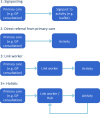What approaches to social prescribing work, for whom, and in what circumstances? A realist review
- PMID: 31502314
- PMCID: PMC7027770
- DOI: 10.1111/hsc.12839
What approaches to social prescribing work, for whom, and in what circumstances? A realist review
Abstract
The use of non-medical referral, community referral or social prescribing interventions has been proposed as a cost-effective alternative to help those with long-term conditions manage their illness and improve health and well-being. However, the evidence base for social prescribing currently lags considerably behind practice. In this paper, we explore what is known about whether different methods of social prescribing referral and supported uptake do (or do not) work. Supported by an Expert Advisory Group, we conducted a realist review in two phases. The first identified evidence specifically relating to social prescribing in order to develop programme theories in the form of 'if-then' statements, articulating how social prescribing models are expected to work. In the second phase, we aimed to clarify these processes and include broader evidence to better explain the proposed mechanisms. The first phase resulted in 109 studies contributing to the synthesis, and the second phase 34. We generated 40 statements relating to organising principles of how the referral takes place (Enrolment), is accepted (Engagement), and completing an activity (Adherence). Six of these statements were prioritised using web-based nominal group technique by our Expert Group. Studies indicate that patients are more likely to enrol if they believe the social prescription will be of benefit, the referral is presented in an acceptable way that matches their needs and expectations, and concerns elicited and addressed appropriately by the referrer. Patients are more likely to engage if the activity is both accessible and transit to the first session supported. Adherence to activity programmes can be impacted through having an activity leader who is skilled and knowledgeable or through changes in the patient's conditions or symptoms. However, the evidence base is not sufficiently developed methodologically for us to make any general inferences about effectiveness of particular models or approaches.
Keywords: health services research; primary care; social and health services.
© 2019 The Authors. Health and Social Care in the Community published by John Wiley & Sons Ltd.
Figures



References
Publication types
MeSH terms
Grants and funding
LinkOut - more resources
Full Text Sources

